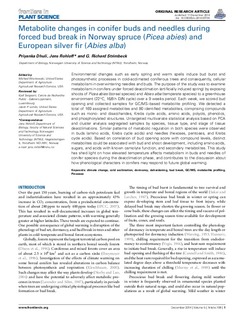| dc.contributor.author | Dhuli, Priyanka | |
| dc.contributor.author | Rohloff, Jens | |
| dc.contributor.author | Strimbeck, Richard | |
| dc.date.accessioned | 2015-01-06T10:23:40Z | |
| dc.date.accessioned | 2016-04-20T11:41:10Z | |
| dc.date.available | 2015-01-06T10:23:40Z | |
| dc.date.available | 2016-04-20T11:41:10Z | |
| dc.date.issued | 2014 | |
| dc.identifier.citation | Frontiers in Plant Science 2014, 5 | nb_NO |
| dc.identifier.issn | 1664-462X | |
| dc.identifier.uri | http://hdl.handle.net/11250/2386497 | |
| dc.description.abstract | Environmental changes such as early spring and warm spells induce bud burst and photosynthetic processes in cold-acclimated coniferous trees and consequently, cellular metabolism in overwintering needles and buds. The purpose of the study was to examine metabolism in conifers under forced deacclimation (artificially induced spring) by exposing shoots of Picea abies (boreal species) and Abies alba (temperate species) to a greenhouse environment (22°C, 16/8 h D/N cycle) over a nine week period. Each week, we scored bud opening and collected samples for GC/MS–based metabolite profiling. We detected a total of 169 assigned metabolites and 80 identified metabolites, comprising compounds such as mono- and disaccharides, Krebs cycle acids, amino acids, polyols, phenolics and phosphorylated structures. Untargeted multivariate statistical analysis based on PCA and cluster analysis segregated samples by species, tissue type, and stage of tissue deacclimations. Similar patterns of metabolic regulation in both species were observed in buds (amino acids, Krebs cycle acids) and needles (hexoses, pentoses, and Krebs cycle acids). Based on correlation of bud opening score with compound levels, distinct metabolites could be associated with bud and shoot development, including amino acids, sugars and acids with known osmolyte function, and secondary metabolites. This study has shed light on how elevated temperature affects metabolism in buds and needles of conifer species during the deacclimation phase, and contributes to the discussion about how phenological characters in conifers may respond to future global warming. | nb_NO |
| dc.language.iso | eng | nb_NO |
| dc.publisher | Frontiers Media | nb_NO |
| dc.rights | Navngivelse 3.0 Norge | * |
| dc.rights.uri | http://creativecommons.org/licenses/by/3.0/no/ | * |
| dc.title | Metabolite changes in conifer buds and needles during forced bud break in Norway spruce (Picea abies) and European silver fir (Abies alba) | nb_NO |
| dc.type | Journal article | nb_NO |
| dc.type | Peer reviewed | nb_NO |
| dc.date.updated | 2015-01-06T10:23:40Z | |
| dc.source.volume | 5 | nb_NO |
| dc.source.journal | Frontiers in Plant Science | nb_NO |
| dc.identifier.doi | 10.3389/fpls.2014.00706 | |
| dc.identifier.cristin | 1177069 | |
| dc.description.localcode | © 2014 Dhuli, Rohloff and Strimbeck. This is an open-access article distributed under the terms of the Creative Commons Attribution License (CC BY). The use, distribution or reproduction in other forums is permitted, provided the original author(s) or licensor are credited and that the original publication in this journal is cited, in accordance with accepted academic practice. No use, distribution or reproduction is permitted which does not comply with these terms. | nb_NO |

